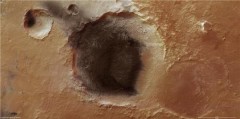Volcanic ash deposits color the Meridian Planum - a plain at the northern end of the Southern Hills on the surface of Mars, seen through a telescope - Plain at the northern end of the Southern Hills on the surface of Mars, seen through the telescope of the European Mars Express spacecraft

Volcanic ash deposits paint the Planum meridian, as seen from the Mars Express space probe. They also hint at the wind directions in this region of Mars. Meridian Planum, a plain at the northern edge of the southern hills on the surface of Mars, is visible through the HRSC telescope as a dark and dramatic region at the equatorial equator.
Meridian Planum is about 127 km long, 63 km wide, and it spreads over an area the size of Cyprus. It was chosen as a landmark in the geographic coordinate system of Mars, so that the area is equal to Greenwich Mean Time.
The High Resolution Stereo Camera (HRSC) photographed the plane and recorded it on September 1, 2005, during the 2097th orbit, with a resolution of about 13 m per pixel.
In the center of the image, the bottom of a 50 km wide impact crater is covered with dark material. The material is similar to volcanic ash, and it contains minerals such as pyroxene and olivine. Small amounts of lighter material are scattered over the surface of the crater, apparently this is a heavier material. Brighter and lighter material crumbled and was blown out of the crater by northeast winds, now it has landed in the outer regions.
A small impact crater with a diameter of 15 km, which is in the image above left, shows the same dark material at its southwestern end. It is likely that the material was also blown into the smaller crater from the large crater. The black structures are most likely dunes formed from volcanic dust rich in sediments. In contrast, an impact crater with a diameter of 34 km in the lower right part of the image is filled with the light material.

4 תגובות
Yair,
Thanks!
Max Power,
I'm not sure about that..
I understand that this is lava that erupted from the Martian crust following an asteroid impact, probably billions of years ago, correct me if I'm wrong.
Glad you're back, you were missing on the site...
what?? The ash cloud has already reached Mars?! It's terrible now they will stop the flights there as well, oh my vacation is gone!